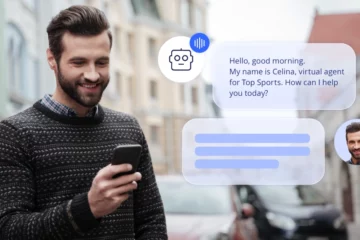As telecommunications operators navigate a complex and ever-evolving global industry landscape, emerging technologies such as generative AI (GenAI) and stand-alone 5G are driving significant changes. These innovations present both opportunities and challenges, raising important questions about business resilience and the potential for service innovation. Hyperautomation is emerging as a powerful strategy to address these challenges and transform the sector.
Hyperautomation involves the use of advanced technologies—such as artificial intelligence (AI), machine learning (ML), robotic process automation (RPA), and business process management (BPM)—to automate complex business processes. This approach extends beyond simple automation, it aims to integrate and optimize various systems and workflows, offering substantial improvements in efficiency and effectiveness.
Generative AI and Its Transformative Potential
Generative AI, with its capability to create and analyze data-driven content and insights, offers telecom operators transformative possibilities. It enables advanced automation across multiple areas, including customer service, marketing, sales, and technical support. By leveraging AI-powered systems, telecom companies can handle routine inquiries, personalize customer interactions, and optimize overall operations, leading to enhanced operational efficiency and improved customer satisfaction.
Marketing and Sales automation
-
Lead management and customer segmentation: GenAI can analyze user behavior across various digital platforms, such as social media, websites, and mobile apps. By understanding how potential customers interact with content and services, telecom companies can identify and target leads with tailored messaging and offers.
For example, ML models automate lead scoring based on conversion likelihood: A lead who fills out a call-me-now form differs significantly from one who just visited the pricing page or another who merely opened a promotional email.
- Marketing automation: Advanced software automates the deployment and management of omnichannel marketing campaigns, ensuring messages reach the right audience at the optimal time. This automation reduces manual effort and enhances campaign efficiency.
For example, a workflow can be designed to send a WhatsApp message with an exclusive offer for an unlimited data plan, followed by a detailed email with more information about the offer. If the customer does not convert, the system can schedule a reminder SMS with a limited-time offer directing them to a personalized landing page that provides an additional offer or special discount.
- Enhanced revenue opportunities: By analyzing customer data in real-time, telecom operators can identify sales opportunities, tailor promotions, and facilitate cross-sells and up-sells during customer interactions. This data-driven approach leads to more effective sales pitches, higher conversion rates, and increased average deal sizes.
A customer with a high-speed internet package could be offered a subscription to a premium streaming service or an online gaming platform, complementing the high performance of their internet connection. The promotion could include a special offer, such as a discount on the first month or a free trial.
- AI-Powered sales bots: AI-driven sales bots interact with potential customers, answer their questions, and guide them through the sales process. These bots provide personalized product recommendations, offer promotions, and assist with the purchase process. Automating the sales process increases efficiency and conversion rates, benefiting overall sales performance.
For a telecom company, it might look like this: the bot guides the customer through the purchase process, helping them select the right plan for their newly acquired mobile device by asking questions like “How do you typically use your mobile phone?” or “Are you looking for a national unlimited data plan or one with international data consumption?”
A fully automated Call Center experience
- Bot Assistants: RPA, GenAI, and ML can build bot assistants that instantly pull up relevant customer information from various systems and databases, such as CRM platforms, billing systems, and service records. This immediate access enables agents to quickly understand the context of a customer’s issue and provide a solution on the spot. These bots also provide agents with actionable insights and recommendations based on data analysis, helping them make informed decisions and offer tailored solutions, thereby improving service quality.
- Unified customer experience: Integrating communication channels into a single platform involves consolidating various customer interaction points into one cohesive system. A unified platform acts as a central hub for all customer interactions, aggregating data from different channels. This centralized approach ensures that customer information, interactions, and history are accessible in one place, providing a comprehensive view of the customer’s journey. Automation tools route customer inquiries to the most appropriate channel or agent based on factors such as the nature of the inquiry, the customer’s history, and the agent’s expertise. This ensures that each inquiry is handled by the most qualified resource, leading to faster and more effective resolutions.
- AI-Powered chatbots: AI-powered chatbots manage a high volume of customer inquiries, offering instant responses and resolutions to common issues. Operating 24/7, these chatbots reduce wait times and enhance customer satisfaction. They also escalate more complex issues to human agents, ensuring customers receive the necessary support.
Five-star service installation
- Real-time updates: After a customer has purchased a service, follow-up bots send automatic notifications at key stages of the installation process. These notifications include updates on order processing, scheduling, dispatch of installation teams, and completion status. Keeping customers informed reduces anxiety and ensures they are aware of what to expect next. This proactive approach ensures a smooth installation process, minimizes service disruptions, and enhances customer satisfaction.
- Automated scheduling: Bots can automatically schedule installation appointments based on customer preferences and availability. Customers receive confirmation of their appointment time, and any necessary adjustments are communicated promptly. If a customer needs to reschedule, bots facilitate this process by offering alternative time slots and updating the schedule in real time. This flexibility ensures that customers can easily accommodate changes in their availability without additional hassle.
- Feedback collection: After installation, bots collect feedback from customers regarding their experience. This feedback helps identify areas for improvement and allows the company to address any lingering concerns promptly. In some cases, bots can engage in live conversations with customers to gather detailed feedback. This interactive approach enables customers to elaborate on their experiences and provide more nuanced insights.
An all-in-one platform can consolidate all these hyperautomation functions into a single tool, streamlining processes, boosting operational efficiency, and fostering synergy across various company departments. inConcert’s all-in-one software integrates all the previously mentioned functions into a single platform, and has helped multiple companies simplify their technological infrastructure and reduce operational complexity.



